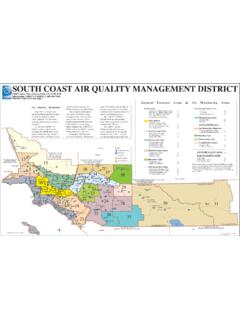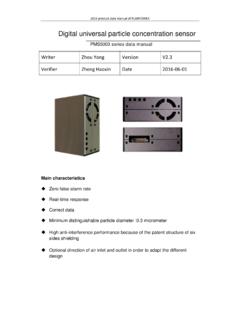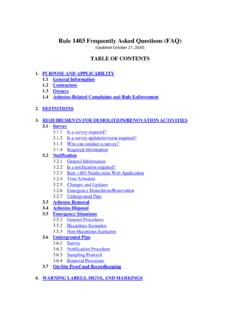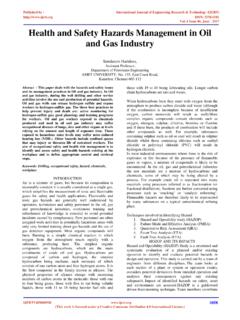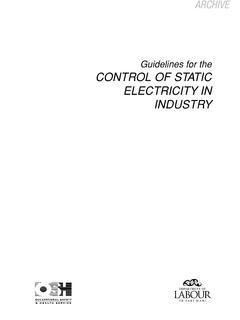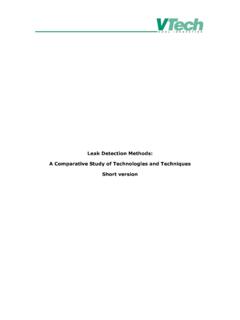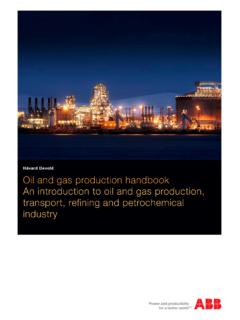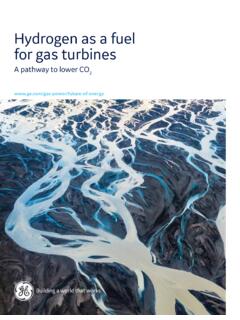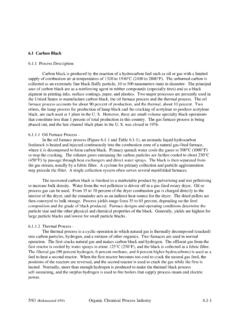Transcription of RULE 1173 CONTROL OF VOLATILE ORGANIC COMPOUND …
1 (Adopted July 7, 1989)(Amended December 7, 1990)(Amended May 13, 1994) (Amended December 6, 2002)(Amended June 1, 2007)(Amended February 6, 2009) RULE 1173 CONTROL OF VOLATILE ORGANIC COMPOUND LEAKS AND RELEASES FROM COMPONENTS AT PETROLEUM FACILITIES AND CHEMICAL PLANTS (a) Purpose This rule is intended to CONTROL VOLATILE ORGANIC COMPOUND (VOC) leaks from components and releases from atmospheric process pressure relief devices (PRDs). (b) Applicability This rule applies to components at refineries, chemical plants, lubricating oil and grease re-refiners, marine terminals, oil and gas production fields, natural gas processing plants and pipeline transfer stations.
2 (c) Definitions: For the purpose of this rule the following definitions shall apply: (1) BACKGROUND is the ambient concentration of total ORGANIC compounds (TOC) in the air at least one (1) meter upwind of the component to be inspected, determined according to the test method in paragraph (j)(1). (2) CHEMICAL PLANT is any facility engaged in producing chemicals, and/or manufacturing products by chemical processes. Any facility or operation that has 282 as the first three digits in its Standard Industrial Classification Code as defined in the Standard Industrial Classification Manual is included in this definition.
3 (3) COMMERCIAL NATURAL GAS is a mixture of hydrocarbons, with at least 80 percent methane by volume and less than 10 percent by weight VOC, determined according to test methods specified in paragraph (j)(2). (4) COMPONENT is any valve, fitting, pump, compressor, pressure relief device, diaphragm, hatch, sight-glass, and meter in VOC service. They are further classified as: (A) MAJOR COMPONENT is any 4-inch or larger valve, any 5-hp or larger pump, any compressor, and any 4-inch or larger pressure relief device.
4 1173 - 1 Rule 1173 (Cont.) (Amended February 6, 2009) 1173 - 2 (B) MINOR COMPONENT is any component which is not a major component. (5) COMPRESSOR is a device used to compress gases and/or vapors by the addition of energy, and includes all associated components used for connecting and sealing purposes. (6) FACILITY is a refinery, chemical plant, lubricating oil and grease re-refiner, marine terminal, oil and gas production field, natural gas processing plant, or pipeline transfer station.
5 (7) FIELD GAS means feed stock gas entering the natural gas processing plant. (8) FITTING is a device used to attach or connect pipes or piping details, including but not limited to flanges and threaded connections. (9) HATCH is any covered opening system that provides access to a tank, container or vessel. (10) HEAVY LIQUID is any liquid with 10 percent or less VOC by volume evaporated at 150 C (302 F), determined according to test methods specified in paragraph (j)(2) or (j)(3).
6 (11) INACCESSIBLE COMPONENT is any component located over five meters above ground when access is required from the ground; or any component located over two meters away from a platform when access is required from the platform; or any component which would require the elevation of a monitoring personnel higher than two meters above permanent support surfaces. (12) INSPECTION is a survey of components, using an appropriate analyzer, according to the test method in paragraph (j)(1), for the purpose of determining compliance with this rule, and may be either of the following: (A) OPERATOR INSPECTION is a survey of components by the operator or their contractor.
7 (B) DISTRICT INSPECTION is a survey of components by District personnel or their representatives. (13) LEAK is the dripping of either heavy or light liquid; or the detection of a concentration of TOC above background, determined according to the test method in paragraph (j)(1). (14) LIGHT LIQUID is any liquid with more than 10 percent VOC by volume evaporated at 150 C (302 F), determined according to the test method specified in subparagraph (j)(2). Rule 1173 (Cont.) (Amended February 6, 2009) 1173 - 3 (15) LUBRICATING OIL AND GREASE RE-REFINER is a facility engaged in the blending, compounding, and re-refining of lubricating oils and greases from purchased mineral, animal, and vegetable materials, as defined in Standard Industrial Classification Code 2992.
8 Petroleum refineries engaged in the production of lubricating oils and greases are classified in Standard Industrial Classification Code 2911 and therefore are not included in this definition. (16) MARINE TERMINAL is a facility, equipment or structure constructed to handle the loading or unloading of ORGANIC liquid into or out of marine tank vessels, defined as in Standard Industrial Classification Codes 4226 and 5171. (17) NATURAL GAS PROCESSING PLANT is a facility engaged in the separation of natural gas liquids from field gas and/or fractionation of the liquids into natural gas products, such as ethane, propane, butane, and natural gasoline.
9 Excluded from the definition are compressor stations, dehydration units, sweetening units, field treatment, underground storage facilities, liquefied natural gas units, and field gas gathering systems unless these facilities are located at a natural gas processing plant. (18) OIL AND GAS PRODUCTION FIELD is a facility on which crude petroleum and natural gas production and handling are conducted, as defined in the Standard Industrial Classification Manual as Industry No.
10 1311, Crude Petroleum and Natural Gas. (19) PIPELINE TRANSFER STATION is a facility which handles the transfer and storage of petroleum products or crude petroleum in pipelines. (20) PLATFORM is any raised, permanent, horizontal surface for the purpose of gaining access to components. (21) PRESSURE RELIEF DEVICE (PRD) is a pressure relief valve or a rupture disc. (22) PRESSURE RELIEF VALVE (PRV) is a device which is automatically actuated by upstream static pressure to the atmosphere (atmospheric PRV) or to a CONTROL device, and used for safety or emergency purposes.
